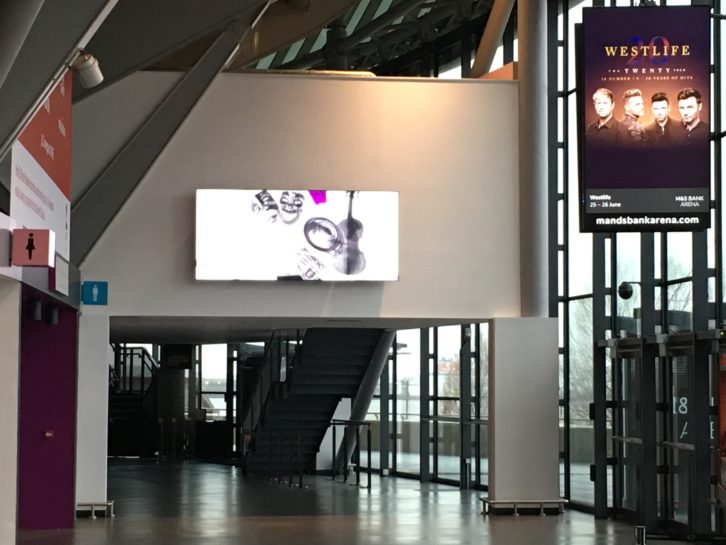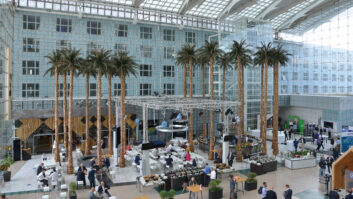
While much of the current discussion in the digital signage world is about what’s behind the screen – the sensors, the AI, the CMS, the links to CRM systems and so on – the choice of the screen itself is no less important than it has ever been. Ian McMurray asks the industry’s advice.
A digital signage screen represents the public face of the enterprise. Unlike in the early days, when there were indeed some pretty bad flat screens out there, today, there’s no such thing – but that doesn’t mean all screens are created equal.
The industry is pretty much unanimous: when choosing the screen – forget about the screen. Yes, there is a choice between LCD, LED, projection – and even, to a limited extent, OLED – but none is ‘better’ than the other.
“Each technology offers a different set of features and benefits,” notes Jasmin Stemmler, product marketing manager at NEC Display Solutions Europe. “What’s crucial is gaining a clear understanding of what you’re trying to achieve before deciding on the technology to use. Key factors to consider include viewing distance, ambient brightness, operation time, interactive requirements, mounting infrastructure and, indeed, budget.”
“Digital signage is not a ‘one-size fits all’,” adds Drew Rogers, senior product manager, large format displays at Samsung Electronics (UK), “and so it is important to take into consideration what the organisation wants to achieve from the display and to understand the needs.”
Desired outcome
Laila Hede Jensen, board member of the Digital Signage Organisation (DSO), agrees. “The project should always be led by the desired outcome and strategy to engage the end user,” she says. “It’s important for those involved in planning the project to ask ‘what is my message, and what am I trying to achieve?’ This should come before any decision on technology.”
That said: a screen has to be chosen… Perhaps the first issue is where the screen will be located. High ambient light means the need for a higher brightness screen – but lower brightness may be more appropriate for parts of a store interior with lower ambient light.
“In general, the 450 nits that’s typical of many screens is nowhere near enough for the average retail environment,” says Florian Rotberg, managing director of digital signage consultancy invidis.
And if the plan is to deploy the screen outdoors?
“Outdoor displays are available with different levels of ingress protection (IP),” Rotberg continues, “making them less susceptible to the weather. Look out also for screens with filters and active cooling to protect against the heat of the sun.”
Indoors or outdoors isn’t the only consideration. Will the screen typically be seen face-on – or will it be in an environment where it will often be seen from the side?
“In those cases,” says Rotberg, “angle of view is important. The wider it is, the more clearly visible the image is from almost any position.”
Size also matters. What will the typical viewing distance be? A large screen may be appropriate for attracting a crowd from a distance – but will overpower a viewer who is close to it.
Commercial grade
Cost, of course, will always be a consideration.
“Many customers select domestic screens rather than commercial screens for reasons of price – but these miss the mark on quality of viewing as well as long-term reliability in a 24/7 environment,” says Helen Kenniff, product marketing manager at Sedao Digital Signage. “We recommend end users invest in the best commercial-grade products they can afford – and we back them with a five-year warranty.”
There’s also the temptation to look only at initial purchase price – a mistake, Stemmler believes.
“A lack of appreciation of the comparative costs associated with digital signage deployments is all too common,” she claims. “Often, buyers ignore the fact that the initial buying price reflects only 30% of the total investment, leading to false economy with a solution that’s not fit for purpose.”
“Customers are increasingly aware of their impact on the environment,” adds Kenniff. “They’re looking, not only at the green credentials of manufacturers, but also whether they use technologies that save energy and reduce long term cost of ownership.”
“Robustness and longevity are vital in maintaining peak performance over an extended life time to minimise operational costs and ensure investment security,” echoes Jensen.
“And,” she adds, “digital signage screens are often a single element in a larger estate, so support for centralised monitoring and control will ensure effective management of the signage network.”
Installability also is too easily overlooked.
“Very large screens may be impressive,” says Rotberg, “but will they go through the door? And: is the structure on which it’s planned to mount them capable of taking their weight? The wrong decision could end up in significantly higher installation costs.”
Compelling case
With all the above said: LED is increasingly making a compelling case for itself – not least because its inherent modularity can lead to unprecedented levels of creativity.
“With its modular architecture, excellent levels of brightness and contrast, high refresh rates, wide colour gamuts and long life – LED now presents itself as a great option for digital signage projects,” believes Jensen.
“Video walls are starting to lose relevance in the face of what LED can do,” adds Rotberg. “Any wall larger than six displays is mostly built with LED nowadays. LED is module-based, so almost any shape and form is possible. But, in contrast to LCD displays, LED is not typically a finished product – although recently, manufacturers have started offering ready-to-use LED solutions that are designed to compete with LCD.”
Choosing a screen is, as noted at the outset, first and foremost a function of the planned application. However: it’s perfectly possible to choose a solution of the appropriate size, brightness and resistance to environmental conditions; that is built for 24/7 operation; that can be installed with minimal disruption; that is environmentally friendly and boasts a low cost of ownership; and that enables the required level of creativity – but that still misses the mark because of poorly executed, out of data, irrelevant content. But that, as they say, is a whole other story.







